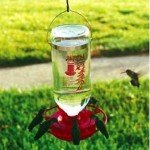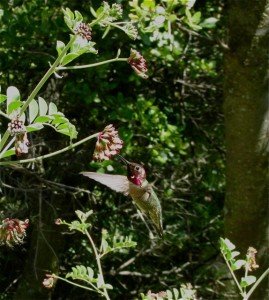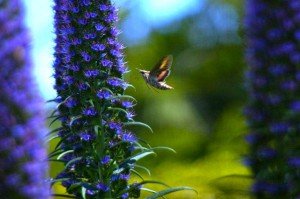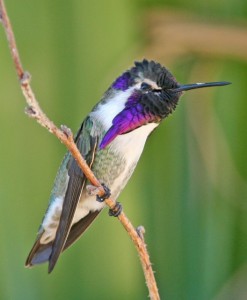People obviously love hummingbirds. A large audience came to hear Kurt Leuschner, a professor at Palm Desert’s College of the Desert, speak to the Redlands horticulture group about hummingbirds. He started out reminding us that we’re lucky. While folks in the East get excited about their one species, the Ruby-throated, that’s better than Europe, Africa and the rest of the Old World – which have none. Here in Southern California we’re blessed to see at least a half-dozen hummingbirds and double that if you travel to Southeast Arizona. There’s a lot of info online about them so I’ll give a rundown on aspects that surprised me.
They’re Smart and Short-lived Hummingbirds have the largest brain in proportion to their body. But they don’t live long. The record for a hummingbird is 12 years but usually only live three to five years. Leuschner said this follows the general rule that larger birds live longer.

Feeder Rules – Don’t Use Red Dye Native plants, along with some exotics that bloom year-round is best for feeding hummingbirds. However, feeders help during those times when little is blooming. But he warned, “Don’t use red dye – it’s not necessary and it’s bad for hummingbirds.” He recommended using ordinary sugar, using water that is hot (it doesn’t have to be boiled), enough to dissolve the sugar at four parts water to one part sugar. Get a feeder that comes apart and cleans easily. Leuschner prefers one called the Best Hummingbird Feeder. Change the juice once a week and wash it with dish soap. I also learned that if you’re going to have more than one, it’s best to spread them out so that one territorial male doesn’t hog them all. Leuschner’s technique is to have one on each corner of his house so four resident males can each guard one as their territory.
Valuable Insect Eaters Hummingbirds need to eat one-half their body weight each day, and especially in breeding season they eat a lot of insects. One of the talk’s attendees was Highland resident Peter Brierty, who recently retired as the San Bernardino County’s Assistant Chief and Fire Marshall. One of his many projects was helping residents reduce potential fire fuel caused by infestations such as the bark-beetle. “I was driving down to visit a resident who had a large property of old trees at risk of infestation,” said Brierty, who was surprised that so many trees in the forest were dead while this residents’ and his adjacent neighbors were healthy. The only difference he could see was the dozens of hummingbirds attracted to the property’s dozen feeders, who appeared to also be eating the tiny insects up in the trees.
Southern California Species The Anna’s hummingbird is our common, year-round hummingbird in the Inland Empire, but Leuschner discussed five other species, along with info about when you’ll likely see them and what to look for. The colorful descriptions below are the males; although in some species the females will show some color.

- Anna’s: The Anna’s Hummingbird has the crimson-red throat, and lives year-round in the Inland Empire, though it may migrate up to the mountains in summer.
- The purple-throated Costa’s Hummingbird is common in the desert (it used to be called the desert hummingbird). French researchers, the first to study it, gave it a French name.
- The Black-chinned Hummingbird, which, surprise, has a black chin with purple under it, will be seen only in summer, most often in Coachella Valley or Big Morengo Canyon.
- The Rufous Hummingbird is bright orange (the female shows some orange too), very aggressive and makes a buzzing sound. In fall and spring, it migrates through on its way to/from the Rockies or Sierras, often traveling over 1500 miles.
- Allen’s Hummingbird is more common near Los Angeles but is sometimes seen here, and sports orange and green on its back.
- The Calliope is very small, has some orange colors like the Rufous. Best seen in the fall up in the San Jacinto mountains or upper San Bernardino Mountains.
- Lastly, the Broad-tailed Hummingbird is seen in the Arizona desert migrating through. It’s male makes a whirring, mechanical sound.
Leuschner also shared his favorite places to see hummingbirds and other birds, which I’ve written up in Favorite Birding Spots in Inland Southern California.


Great piece Linda – thanks for sharing this information about these little beauties! Anne
I live in Miami, Florida, and I know that Hummers only visit my region when they come down for later fall through the winter and leave mid spring. When I was a kid back in the 6O I used to see Cardinals numerous other birds and Hummers. Now besides the pigeons, one can still see Blue Jay. People I think have stopped putting feeders out because they do not seem to come any more. I have an x girlfriend from college in Tallahassee who does continue to put humfeeders in their suburban.
A question, the Sphinx moths do they fly at night?
Sorry, I missed this comment – I’ve just seen the sphinx moths during the day so not sure about nite flying. I was surprised how large they were, look like hummingbirds.
I live in palm springs California. We’ve enjoyed watching the costas and the Anna’s. We had a few territorial birds males and females each adopt their own feeders, I have 4, with a few females sneaking in throughout the day. The territorial ones never left their spots near their feeders during the day. However I haven’t seen them for about a month now. I have 2 or 3 females that fly in feed and leave. We’ve diligently washed our feeders 1 to 2 times a week for as long as we’ve had them. We put them up in October. I’m worried that maybe a cat got them. Is there any other reason the usual suspects that were always in their favorite spots near their feeders would now be gone?
I’m really missing these little guys they each had such distinct funny personalities.
No worries – answer from Kurt Leuschner, College of the Desert biology prof, Desert Cities Bird Club… This time of year (starting in late January or early February and continuing through April) local hummingbirds are busy pairing up and staking out a territory and building/tending nests and young. They may even raise two broods if conditions are right. Two eggs per nest is typical.
They may leave your yard and disperse into different areas to nest and the females start to gather cobwebs for nesting material and to consume insects as well as nectar in order to provide their growing young with a protein “smoothie”.
So you may not notice as many hummingbirds around your feeders during the nesting season as one yard may only be big enough for a couple of hummingbird pairs. This drop in numbers at your feeder is normal and nothing to be worried about. Be patient and they will return once the young are on their own.
Do the hummers in Crestline and Lake Arrowhead stay all winter? If so, what do I feed them?
Anna’s hummingbirds should be year-round residents up there. If you see them a feeder with the sugar solution (without red dye) would be nice, although we don’t feed them anything extra except the flowers and bugs we have on our property.
I live in the desert in San Bernardino county and we have so many hummingbirds, I have to fill the feeder every day. We have a new one that is a very pretty orange, thank you for the info on him! Most of them have either a red head or a very deep pretty purple head. This is our first orange one. They aren
that’s great Jennifer, I’m sure you have some native plants around too to help keep them fed
I have noticed the past few weeks I am not seeing hummingbirds that use to be around all the time. Where are they????
Hi Joy, with the cool spring some birds and the blooming of plants is occurring later that usual – hope that’s why!